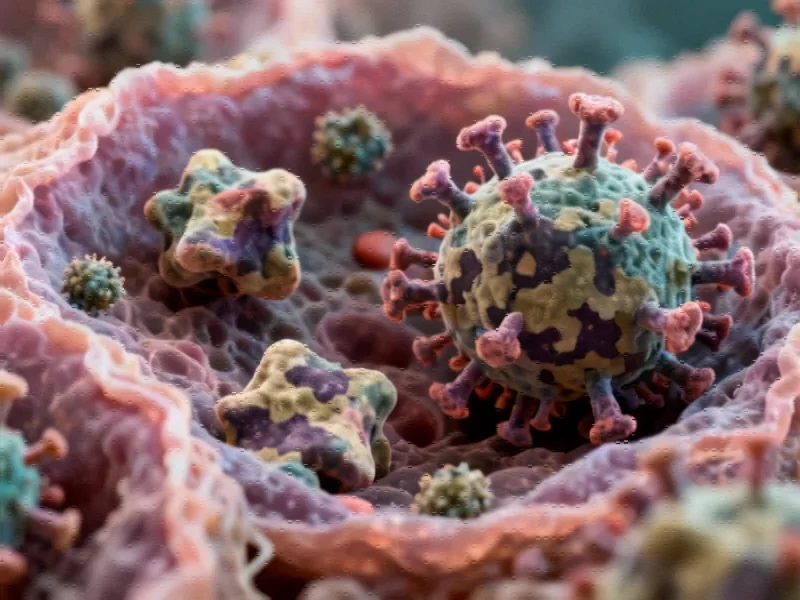**
HIV’s Elusive Hiding Places Mapped in Human Tissues
Researchers have made a significant breakthrough in understanding how HIV manages to evade eradication by hiding in dormant reservoirs throughout the human body, according to a new study. The findings, which analyzed rare tissue samples, reveal that the virus does not integrate randomly into a host’s DNA but instead follows unique, tissue-specific patterns. This cunning strategy allows it to persist for decades, even during effective antiretroviral treatment.
The Challenge of the Latent HIV Reservoir
The primary obstacle to curing HIV is its ability to establish a latent infection. During this stage, the virus becomes a provirus, inserting its genetic blueprint directly into the host cell’s DNA and entering a dormant state. Sources indicate that modern antiretroviral drugs can suppress active viral replication but cannot target these hidden, inactive proviruses. This forces patients to continue lifelong therapy to prevent a viral rebound.
Previous research has shown that HIV can linger in a wide variety of body tissues, including the brain, kidneys, and gastrointestinal tract. While immune cells known as T helper cells are considered the main reservoir, the virus has also been found in skin cells and organ-specific cells. However, the precise mechanisms of how it infiltrates and settles into these diverse locations have remained poorly understood.
A Tissue-Tailored Strategy for Survival
The new study provides unprecedented detail on this process. According to reports from the research team, HIV employs a sophisticated, tissue-specific approach to cloaking itself. The virus adjusts its integration behavior to fit the local cellular environment, allowing it to remain hidden. For instance, in brain tissue, the virus was found to avoid active genes and instead hide in less active regions of the host’s DNA.
“We found that HIV doesn’t integrate randomly. Instead, it follows unique patterns in different tissues, possibly shaped by the local environment and immune responses,” microbiologist Stephen Barr from Western University stated in the university’s report. “This helps explain how HIV manages to persist in the body for decades, and why certain tissues may act as reservoirs of infection.”
Historic Samples Provide a Path Forward
The research, published in a scientific journal, was made possible by analyzing preserved tissue samples from the early years of the HIV/AIDS pandemic. These samples, collected before modern treatments were available, allowed scientists to observe the virus in its natural state across multiple organs from the same individuals.
Analysts suggest that this discovery underscores the immense value of biobanks and historic sample preservation. “Our study is a powerful example of how we can learn from historic samples to better understand a virus that continues to affect tens of millions of people worldwide,” Barr said. The researchers involved in this project are also monitoring related innovations in biomedical research that could aid their work.
New Hope for Targeted Therapies
This detailed mapping of HIV’s hiding spots opens new avenues for developing a cure. The report states</strong that by knowing exactly where the virus lurks within the human genome, scientists can now work on designing therapies that specifically target these reservoirs.
“Knowing where the virus hides in our genomes will help us identify ways to target those cells and tissues with targeted therapeutic approaches – either by eliminating these cells or ‘silencing’ the virus,” explained molecular virologist Guido van Marle from the University of Calgary. This approach aligns with broader industry developments in precision medicine.
A Legacy of Generosity in the Face of Adversity
The researchers emphasized that this critical discovery would not have been possible without the individuals who volunteered for HIV research during a time of great stigma and fear. “Their willingness to contribute samples, at a time of stigma, fear, and with limited treatment options, was an act of bravery, foresight, and generosity that continues to advance scientific understanding of HIV and save lives today,” van Marle said. This human contribution stands in contrast to other sectors, such as the market trends seen in some tech startups. The study’s findings also contribute to the ongoing global discussion, much like analyses of the human rights landscape in various regions, by highlighting the long-term impact of past decisions and contributions. As the field progresses, researchers will continue to watch recent technology for tools that could further accelerate this vital research.
This article aggregates information from publicly available sources. All trademarks and copyrights belong to their respective owners.
Note: Featured image is for illustrative purposes only and does not represent any specific product, service, or entity mentioned in this article.



